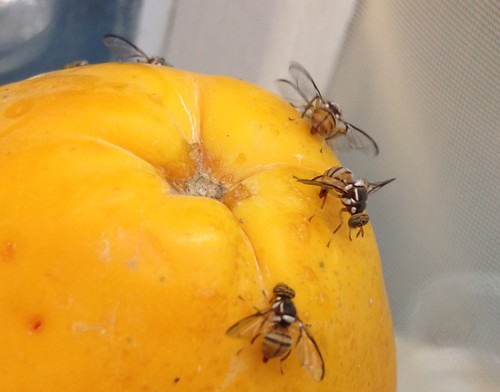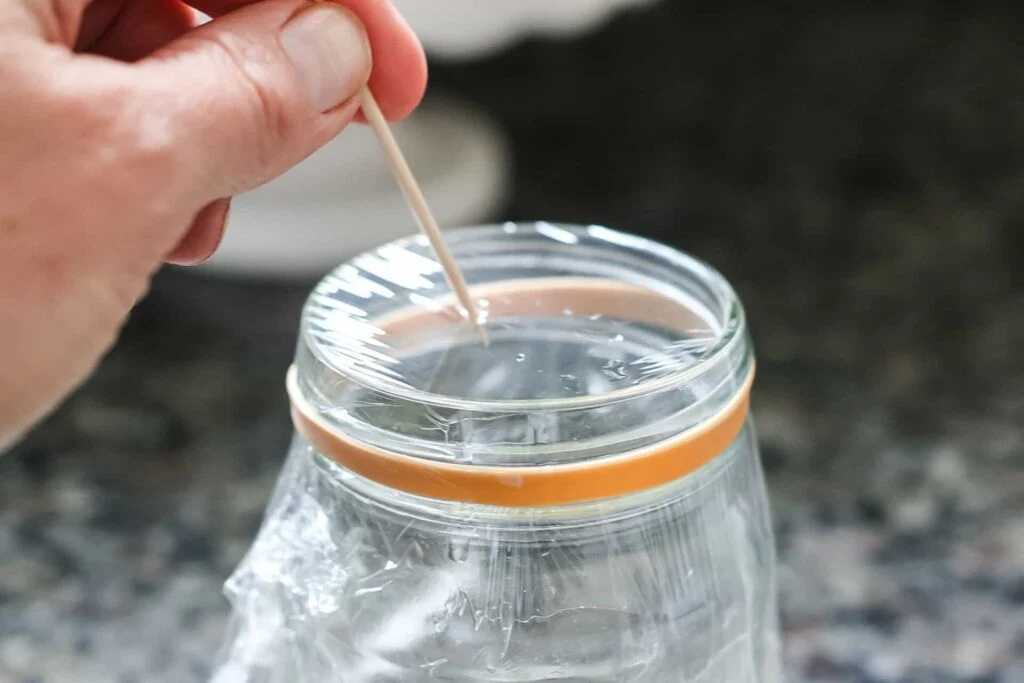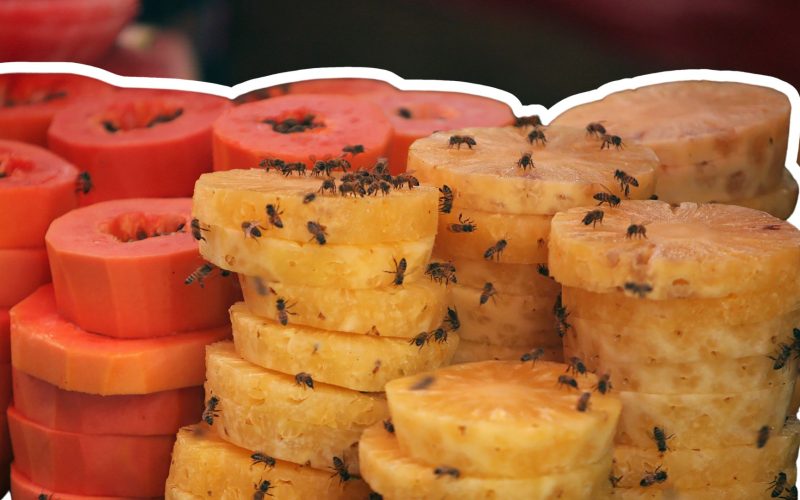Tired of smacking at those pesky fruit flies in your kitchen? You’re not alone. These tiny, persistent insects seem to appear out of nowhere, leaving many wondering how to get rid of fruit flies for good.
They’re more than just a nuisance; fruit flies can potentially spread bacteria, posing health risks. With females laying up to 50 eggs daily, a small problem can quickly spiral out of control.
This guide explores effective methods to eliminate fruit flies from your home. Whether you’re dealing with a minor annoyance or a full-blown infestation, you’ll find practical solutions to reclaim your kitchen.
We’ll cover everything from understanding these tiny invaders to crafting DIY traps and implementing prevention strategies.
Understanding Fruit Flies

Before we dive into elimination methods, we must understand what we’re dealing with. Fruit flies are small, reddish-brown flies with distinctive red eyes.
They’re attracted to ripe or fermenting fruits and vegetables and sugary substances like soda and alcohol.
These tiny insects have an alarmingly short life cycle. A female can lay hundreds of eggs at a time, usually on moist surfaces of fermenting foods.
Fruit fly eggs hatch in just 24 hours, with larvae feeding on decaying matter. In only a week, these larvae transform into adult flies, ready to mate and start the cycle again, explaining why infestations grow so quickly.
Fruit flies thrive in warm, moist environments, often hovering around kitchen sinks, garbage disposals, trash cans, and fruit bowls.
Immediate Actions to Eliminate Fruit Flies

Quick steps you can take right away to combat fruit flies. Learn how to remove attractants, clean your kitchen thoroughly, and make your environment less appealing to these pests.
1. Dispose of Attractants
- Toss ripe or rotting produce, checking all fruits and vegetables.
- Inspect less obvious places like cupboards or fruit bowls in other rooms.
- Store fresh produce in the refrigerator or airtight containers when possible.
2. Clean Thoroughly
- Wipe all kitchen surfaces with disinfectant, including under appliances and in crevices.
- Clean drains and garbage disposals with enzyme-based cleaners and boiling water.
- Empty and clean all garbage bins, including compost containers, with a bleach solution.
3. Create an Inhospitable Environment
- Turn up the air conditioning to lower the overall temperature.
- Use a dehumidifier in damp kitchen areas.
- Improve ventilation by opening windows or using fans.
- Install screens on windows to allow fresh air while keeping pests out.
4. Remove Standing Water
- Fix any leaky pipes or faucets.
- Clean pet water bowls regularly.
- Don’t leave dirty dishes or standing water in the sink overnight.
5. Maintain Cleanliness
- Wash and sanitize reusable grocery bags.
- Ensure all trash cans have tight-fitting lids.
- Clean up spills and crumbs immediately.
By methodically addressing these areas, you’ll eliminate current attractants and make your kitchen less inviting to fruit flies, forming a solid foundation for effective control and prevention.
Effective Trapping Methods
Discover easy-to-make traps using common household items. These methods use vinegar, fruit, and other baits to lure and catch fruit flies effectively.
1. Jar and Funnel Trap

- Fill a jar with about an inch of apple cider vinegar or place a piece of overripe fruit inside.
- Create a paper funnel with a small opening at the bottom, about the size of a pencil.
- Place the funnel in the jar, with the narrow end pointing down.
- Fruit flies will enter through the small opening but have difficulty finding their way out.
2. Bottle and Plastic Wrap

- Take a bottle with a small amount of vinegar, beer, or wine left in it.
- Cover the opening tightly with plastic wrap.
- Use a toothpick or fork to poke several small holes in the plastic wrap.
- Fruit flies will be attracted to the scent, enter through the holes, and become trapped.
3. Bowl and Soap Trap

- In a microwave-safe bowl, mix equal parts apple cider vinegar and water.
- Add a few drops of dish soap to break the surface tension.
- Microwave the mixture for about 20 seconds to increase the aroma.
- Leave the bowl uncovered in the problem area.
- The soap causes the flies to sink and drown when they land on the liquid.
Additional DIY Methods
Explore more creative homemade trapping techniques. These methods offer alternatives if the initial traps don’t work, using materials you likely already have at home.
1. Overripe Fruit Trap

- Place a piece of overripe fruit (banana, peach, or apple work well) in a small bowl.
- Cover the bowl tightly with plastic wrap.
- Use a toothpick to poke several small holes in the plastic wrap.
- The fruit attracts the flies, while the plastic wrap prevents their escape.
2. Wine Bottle Trap

- Leave a nearly empty wine bottle out on the counter.
- Add a few drops of dish soap to the remaining wine.
- The narrow neck of the bottle makes it difficult for flies to exit once they’ve entered.
- The soap breaks the surface tension, causing flies to sink if they land on the liquid.
3. Sticky Trap

- Coat yellow index cards or strips of construction paper with honey.
- Hang these near fruit bowls or other areas where you’ve seen fruit flies.
- The bright color attracts the flies, and they get stuck in the honey.
Store-Bought Solutions
Find out about commercial products available for fruit fly control. Compare the pros and cons of store-bought traps and sprays with DIY methods to choose the best option for your situation.
1. Commercial Traps
Several effective commercial products are available for tackling fruit fly infestations:
- Sticky Traps: These use bright colors and adhesive to attract and capture fruit flies. They’re easy to use and dispose of, making them a popular choice for many households.
- Electric Traps: These devices use UV light to lure flies and then trap or electrocute them. They’re designed for continuous use and can be effective for ongoing prevention.
- Chemical Sprays: While effective, especially for severe infestations, these should be used cautiously in food preparation areas. They offer quick action but may require careful application.
2. Comparative Analysis
DIY Traps are cost-effective and use readily available materials. They can be easily customized to suit your specific needs. However, they may be less visually appealing and often require more frequent maintenance.
Store-bought traps are generally more durable and long-lasting. They are often more aesthetically pleasing and may be more potent or effective.
On the downside, they come with a higher initial cost and offer limited customization options.
When choosing between DIY and commercial solutions, consider your specific needs, the severity of the infestation, and your budget. Both options can be effective when used correctly.
Preventive Measures for Fruit Flies
Learn long-term strategies to keep fruit flies away. Understand how proper cleaning, food storage, and kitchen maintenance can prevent future infestations.
Routine Cleaning
Maintaining a clean kitchen is crucial in preventing fruit fly infestations. Regularly clean kitchen surfaces, especially areas where produce is stored.
Wipe down countertops, tables, and inside cupboards at least weekly. Pay special attention to garbage cans and recycling bins, cleaning them thoroughly with a disinfectant solution.
It’s also important to wash and dry produce immediately after purchase to remove any potential eggs or larvae.
Storage Tips
Proper storage of fruits and vegetables is key to preventing fruit fly problems. Store ripe fruits and vegetables in the refrigerator whenever possible.
For items that can’t be refrigerated, use airtight containers or mesh produce bags to limit fruit fly access.
Keep overripe fruits and vegetables in sealed containers or dispose of them promptly. Store onions, potatoes, and other root vegetables in cool, dry places away from other produce.
Regular maintenance of kitchen drains and garbage disposals is also important. Once a week, pour boiling water down drains to eliminate any organic buildup.
For garbage disposals, grind ice cubes and citrus peels to clean the blades and freshen the unit.
Remember, consistency is key in prevention. By incorporating these practices into your routine, you can significantly reduce the likelihood of future fruit fly infestations.
Final Thoughts
Dealing with fruit flies can be frustrating, but with the right approach, you can effectively eliminate them and prevent future infestations.
Remember, the key is to act quickly when you first notice fruit flies, use a combination of trapping methods, and maintain a clean environment that’s unappealing to these pests.
By following the methods outlined in this guide – from immediate actions to long-term prevention – you’ll be well-equipped to handle any fruit fly situation that comes your way.
Your best weapons against these persistent invaders are quick disposal of overripe produce, setting effective traps, and maintaining cleanliness.
You can enjoy a fruit-fly-free home and peace of mind in your kitchen with patience and persistence. Here’s to reclaiming your space and saying goodbye to fruit flies for good!











